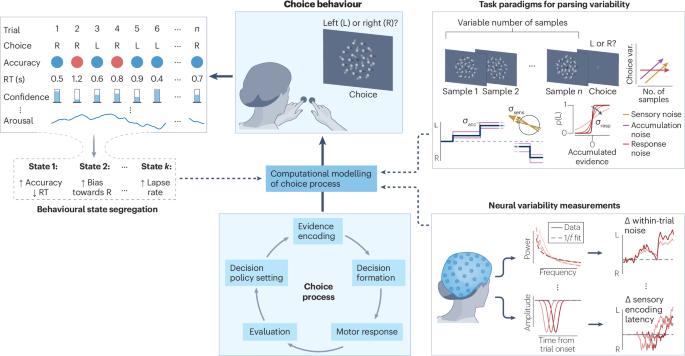Disentangling sources of variability in decision-making
IF 26.7
1区 医学
Q1 NEUROSCIENCES
引用次数: 0
Abstract
Even the most highly-trained observers presented with identical choice-relevant stimuli will reliably exhibit substantial trial-to-trial variability in the timing and accuracy of their choices. Despite being a pervasive feature of choice behaviour and a prominent phenotype for numerous clinical disorders, the capability to disentangle the sources of such intra-individual variability (IIV) remains limited. In principle, computational models of decision-making offer a means of parsing and estimating these sources, but methodological limitations have prevented this potential from being fully realized in practice. In this Review, we first discuss current limitations of algorithmic models for understanding variability in decision-making behaviour. We then highlight recent advances in behavioural paradigm design, novel analyses of cross-trial behavioural and neural dynamics, and the development of neurally grounded computational models that are now making it possible to link distinct components of IIV to well-defined neural processes. Taken together, we demonstrate how these methods are opening up new avenues for systematically analysing the neural origins of IIV, paving the way for a more refined, holistic understanding of decision-making in health and disease. Identifying the psychological and neurobiological processes underpinning intra-individual variations in choice behaviour presents a formidable challenge. In this Review, Duffy et al. discuss how algorithmic models for teasing apart such sources of variability and advances in behavioural paradigm design and neurally grounded computational modelling are providing new avenues for systematic progress.


解开决策中可变性的来源
即使是最训练有素的观察者,在面对完全相同的选择相关刺激时,其选择的时间和准确性也会在试验与试验之间表现出很大的差异。尽管这是选择行为的一个普遍特征,也是许多临床疾病的一个突出表型,但人们对这种个体内变异性(IIV)的来源进行分析的能力仍然有限。原则上,决策计算模型提供了一种解析和估计这些来源的方法,但由于方法上的局限性,这一潜力在实践中未能得到充分发挥。在本综述中,我们首先讨论了算法模型目前在理解决策行为变异性方面的局限性。然后,我们将重点介绍行为范式设计、跨试验行为和神经动态新分析以及基于神经的计算模型开发等方面的最新进展,这些进展使得将 IIV 的不同组成部分与定义明确的神经过程联系起来成为可能。综上所述,我们展示了这些方法如何为系统分析 IIV 的神经起源开辟了新途径,从而为更精细、更全面地了解健康和疾病决策铺平了道路。
本文章由计算机程序翻译,如有差异,请以英文原文为准。
求助全文
约1分钟内获得全文
求助全文
来源期刊

Nature Reviews Neuroscience
NEUROSCIENCES-
自引率
0.60%
发文量
104
期刊介绍:
Nature Reviews Neuroscience is a multidisciplinary journal that covers various fields within neuroscience, aiming to offer a comprehensive understanding of the structure and function of the central nervous system. Advances in molecular, developmental, and cognitive neuroscience, facilitated by powerful experimental techniques and theoretical approaches, have made enduring neurobiological questions more accessible. Nature Reviews Neuroscience serves as a reliable and accessible resource, addressing the breadth and depth of modern neuroscience. It acts as an authoritative and engaging reference for scientists interested in all aspects of neuroscience.
 求助内容:
求助内容: 应助结果提醒方式:
应助结果提醒方式:


